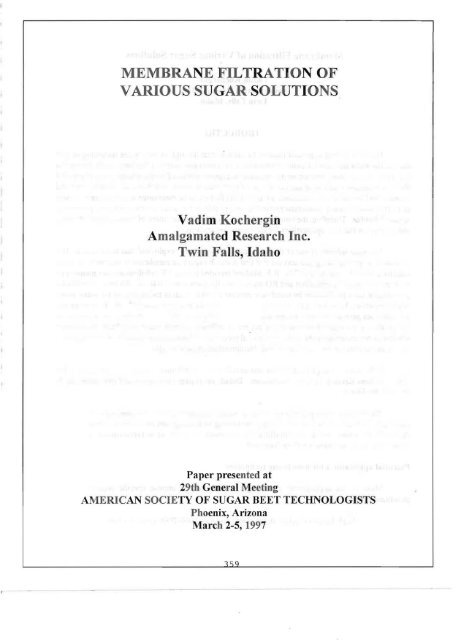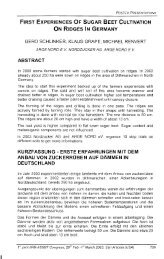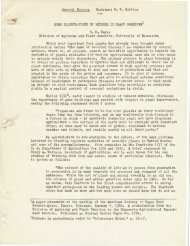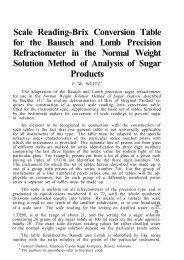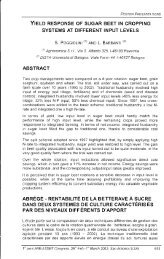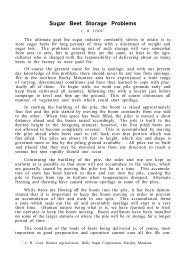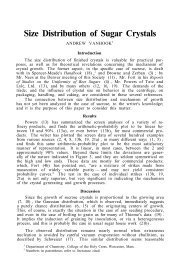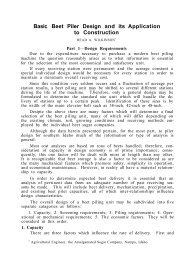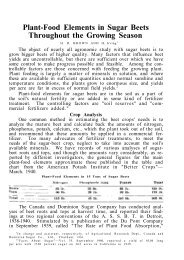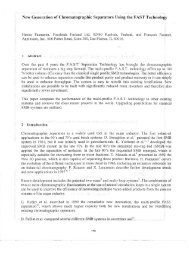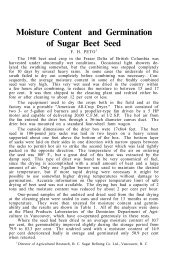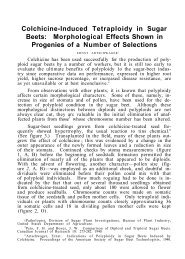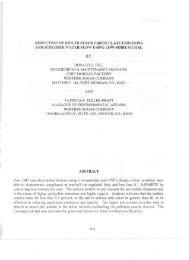membrane filtration of various sugar solutions - ASSBT Proceedings
membrane filtration of various sugar solutions - ASSBT Proceedings
membrane filtration of various sugar solutions - ASSBT Proceedings
You also want an ePaper? Increase the reach of your titles
YUMPU automatically turns print PDFs into web optimized ePapers that Google loves.
,<br />
MEMBRANE FILTRATION OF <br />
VARIOUS SUGAR SOLUTIONS <br />
Vadim Kochergin <br />
Amalgamated Research Inc. <br />
Twin Falls, Idaho <br />
Paper presented at <br />
29th General Meeting <br />
AMERICAN SOCIETY OF SUGAR BEET TECHNOLOGISTS <br />
Phoenix, Arizona <br />
March 2-5, 1997
Membrane Filtration <strong>of</strong> Various Sugar Solutions<br />
Vadim Kochergin<br />
Amalgamated Research Inc.<br />
Twin Falls, Idaho<br />
INTRODUCTION<br />
There are several important reasons for recent breakthrough <strong>of</strong> <strong>membrane</strong> technologies into<br />
most <strong>of</strong>the major industries. Drastic improvement <strong>of</strong><strong>membrane</strong> materials has been made during the<br />
last 10-15 years. New environmental regulations impose additional requirements on conventional<br />
<strong>filtration</strong> processes resulting in increased cost <strong>of</strong>filter cake handling and disposal. Lower costs and<br />
an extended lifetime <strong>of</strong>the <strong>membrane</strong>s are among the factors to be ~entione d in this context. These<br />
and other factors make <strong>membrane</strong> technology applicable in the areas where it was not previously<br />
regarded feasible. Therefore, the time has come to reconsider replacement <strong>of</strong> conventional <strong>filtration</strong><br />
and to develop the new applications for <strong>membrane</strong> separations.<br />
The <strong>sugar</strong> industry is one <strong>of</strong> the few areas that <strong>membrane</strong> "explosion" has not reached. It is<br />
even more surprising taking into account that first research papers on <strong>membrane</strong> applications in <strong>sugar</strong><br />
industry appeared in the early 1970's. R F. Madsen! reported testing UF cellulose acetate <strong>membrane</strong>s<br />
for beet <strong>sugar</strong> juices' purification and RO <strong>membrane</strong>s for juice concentration. An idea <strong>of</strong> replacing<br />
conventional juice purification by <strong>membrane</strong> process fascinated <strong>sugar</strong> technologists for many years.<br />
Numerous efforts have been done to test the feasibility <strong>of</strong> the new processes 2 ,3,4 W. K. Nielsen and<br />
his colleagues gave an extensive review and summary <strong>of</strong> these efforts 5 Variations in juice properties<br />
and analytical procedures shown in the papers <strong>of</strong> different authors make it difficult to conclude<br />
whether or not <strong>membrane</strong>s can replace traditional processes . . Information is available in the literature 6<br />
on use <strong>of</strong><strong>membrane</strong>s for clarification and decolorization <strong>of</strong> cane syrups.<br />
Only recently a large-scale system was installed for ultra<strong>filtration</strong> <strong>of</strong> clarified cane juice. The<br />
system utilizes Kerasep ceramic <strong>membrane</strong>s. Details on system parameters and operation can be<br />
found in the literature 7 ,8.<br />
The purpose <strong>of</strong>this paper is to review possible applications for <strong>membrane</strong> technology in the<br />
<strong>sugar</strong> industry based on the analysis <strong>of</strong> <strong>sugar</strong> processing technology and recent experimental results.<br />
Applications where micro- or ultra<strong>filtration</strong> processes are used as a pretreatment <strong>of</strong> feed to<br />
chromatographic separation will be discussed.<br />
PotentiaJ applications for <strong>membrane</strong> technology<br />
Most <strong>of</strong> the applications in the <strong>sugar</strong> industry would impose specific requirements on<br />
<strong>membrane</strong> characteristics:<br />
1. High fluxes (a typical <strong>sugar</strong> plant produces 1000-2000 gpm <strong>of</strong> juice).<br />
360
2. Temperatures above 85 DC to prevent bacterial growth.<br />
3. Presence <strong>of</strong> small quantities <strong>of</strong> abrasive materials in the raw juice streams.<br />
4. High concentration factors required to minimize <strong>sugar</strong> losses.<br />
Possible applications for <strong>membrane</strong> technology in beet and cane <strong>sugar</strong> industry can be<br />
conditionally divided in two groups: replacement <strong>of</strong> conventional <strong>filtration</strong> processes and the new<br />
developments. Each potential <strong>membrane</strong> process will need to go through a development stage and<br />
subsequent economic evaluation. Replacement <strong>of</strong> traditional <strong>filtration</strong> is still difficult to justify but<br />
the new projects may become more feasible with the increased requirements on handling <strong>of</strong> waste<br />
fIlter-aid. Particularly, cost <strong>of</strong> the equipment necessary to dewater fitter-aid sludge in some<br />
applications may be comparable to the cost <strong>of</strong> a <strong>membrane</strong> system. This will make <strong>membrane</strong><br />
technology look more attractive to <strong>sugar</strong> technologists.<br />
Group 1<br />
l. Standard liquor <strong>filtration</strong> (some companies apply two-stage conventional <strong>filtration</strong>). This<br />
process will eliminate filter-aid usage and disposal but still requires appropriate concentrate<br />
handling process to reduce <strong>sugar</strong> loss.<br />
2. Some factories store thick juice during slicing campaign and process it later in the season.<br />
Thick juice is normally filtered prior to storage to reduce bacterial counts. Juice sterilization<br />
by micro <strong>filtration</strong> can significantly reduce storage losses.<br />
3. Molasses de<strong>sugar</strong>ization systems in the beet industry are very sensitive to the presence <strong>of</strong><br />
suspended solids in the feed streams. Micro- or ultra<strong>filtration</strong> can be extremely efficient for<br />
this application.<br />
Group 2<br />
1. Raw juice micro<strong>filtration</strong> or ultra<strong>filtration</strong> as a part <strong>of</strong> pretreatment prior to chromatographic<br />
separation according to the process patented by The Amalgamated Sugar Company9<br />
Pretreated and filtered raw juice is s<strong>of</strong>tened and evaporated. Resulting syrup is purified using<br />
chromatographic separation. The process has been successfully piloted for four years. Details<br />
about the process can be found in the paper by M. Kearney and D. E. Rearick 10<br />
2. The same approach like the one referenced in paragraph one can be applied to cane juice<br />
purification. It is proven that chromatography is capable <strong>of</strong> removal cane non-<strong>sugar</strong>s and<br />
color very efficiently. Membrane pretreatment will be necessary prior to feeding juice to a<br />
resin bed.<br />
3. Raw juice ultra<strong>filtration</strong> as a replacement to conventional purification method is still difficult<br />
to justify as a stand-alone process. Permeate is more likely to be post-treated with lime to<br />
achieve a purity increase comparable to liming and carbonation.<br />
361
4. Micr<strong>of</strong>iltered raw juice can be stored and processed later. After appropriate testing the<br />
process may be useful for factories with lime kilns undersized to handle an increased slice<br />
rate.<br />
5. Cane molasses pretreatment prior to chromatography should be developed on case to case<br />
basis due to tremendous differences in molasses properties from <strong>various</strong> sources.<br />
6. Micro- or ultra<strong>filtration</strong> may be applied fo r both press water sterilization and suspended<br />
solids removal. Sterjlization will not require heating and subsequent cooling. This process<br />
can be justified if reduction <strong>of</strong> bacteria counts and associated unaccounted loss could be<br />
accopmlished.<br />
7. Micro<strong>filtration</strong> <strong>of</strong> mixed cane juice followed by adsorptionll will remove high molecular<br />
weight materials. Feasibility <strong>of</strong> this process should be carefully studied since adsorption does<br />
not reduce amount <strong>of</strong>highly melassigenic monova.lent cations in the solution which comprise<br />
a major portion <strong>of</strong> non-<strong>sugar</strong>s in the juice stream.<br />
8. Cane juice color may be reduced by the UF in the cane mills and refineries.<br />
New ideas on <strong>membrane</strong> applications continue to appear on a daily basis when new<br />
infonnation on <strong>membrane</strong> performance becomes available. Setting priorities overall is difficult due<br />
to the differences in companies' strategic planning. Priorities are signillcantly affected by new EPA<br />
regulations, cost <strong>of</strong> power and <strong>membrane</strong> systems.<br />
Raw juice purification using simuJated moving bed chromatography<br />
Chromatographic separation <strong>of</strong> raw beet or cane juice provides a new opportunity for<br />
<strong>membrane</strong> application since it does not require any purity increase across the <strong>membrane</strong>. Normally<br />
one would expect a purity rise across the <strong>membrane</strong> in the UF or NF applications. Unfortunately high<br />
separation efficiency is accompanied by low fluxes. Conventional purification processes can remove<br />
only 25-35% <strong>of</strong>total non-<strong>sugar</strong>s, whereas the chromatographic separators remove about 85% <strong>of</strong> non<strong>sugar</strong>s<br />
and color bodies. Most <strong>of</strong> these Don-<strong>sugar</strong>s (e.g., monovalent ions) are considered "nonremovable"<br />
by conventional methods. The separation that is difficult or impossible to achieve using<br />
<strong>membrane</strong> technology alone can be easily accomplished in combination with ion exclusion<br />
chromatography. The chromatographic process does not tolerate suspended solids in the feed stream.<br />
Therefore <strong>membrane</strong> fiitration as a method fo r suspended solids removal and chromatography as a<br />
powerfuJ separation tooL seem to be the most efficient combination for purification <strong>of</strong> <strong>sugar</strong> juices and<br />
syrups.<br />
Most <strong>of</strong> the existing industrial chromatography applications use the simulated moving bed<br />
(SMB) principle l 2, 13 An 5MB system usually comprises one or several columns filled with separation<br />
medium, e.g. ion-exchange resins in separation <strong>of</strong><strong>sugar</strong>s. In the SlVIB process feed stock and eluent<br />
are continuously added to the system. The points <strong>of</strong> feed and eluent introduction and products<br />
withdrawal are switched periodically simulating countercurrent movement <strong>of</strong> separation media. By<br />
362
varying the ratio between product fractions it is possible to build up an internal component inventory<br />
inside the system. Most importantly only fractions <strong>of</strong> the inventory are removed as products. The<br />
rest <strong>of</strong> components keep recirculating inside a closed loop. A principle flow diagram <strong>of</strong> an SNfB<br />
process with eight cells is shown in Figure 1. Due to the multi-pass nature <strong>of</strong> SNfB processes higher<br />
product purity and recovery can be achieved.<br />
Continuous recirculation <strong>of</strong> components inside SNfB system imposes strict requirements on<br />
suspended solids elimination out <strong>of</strong>feed streams. Backwashing <strong>of</strong> separator cells is considered as an<br />
emergency mode <strong>of</strong> operation rather than a routine procedure. Raw beet juice contains a very wide<br />
spectrum <strong>of</strong> suspended solids ranging in size from a fraction <strong>of</strong> a micron to several millimeters.<br />
Conventional processes can easily remove the coarser particles but only <strong>membrane</strong> technology may<br />
be a viable option for removal <strong>of</strong> submicron particles. Juice sterilization as a side effect <strong>of</strong> <strong>membrane</strong><br />
<strong>filtration</strong> is expected to benefit downstream operation.<br />
RESULTS AND DISCUSSION<br />
In spite <strong>of</strong> continuous efforts <strong>of</strong> many researchers very little information has been published<br />
on the performance <strong>of</strong>micro<strong>filtration</strong> or ultra<strong>filtration</strong> systems. A principle possibility <strong>of</strong> beet juice<br />
micro<strong>filtration</strong> was shown in the paper by specialists from Southern Minnesota Beet Sugar<br />
Cooperative and Dow Chemical Company14. Presented data are not sufficient though to make any<br />
conclusion about the feasibility <strong>of</strong> a new process. Paper presented by R. Kwok at the Sugar<br />
Processing Research Institute Workshop? gives detailed description <strong>of</strong> a <strong>membrane</strong> application for<br />
ultra<strong>filtration</strong> <strong>of</strong> clarified cane juice. After two years <strong>of</strong> operation the <strong>membrane</strong> <strong>filtration</strong> was still<br />
in the development phase.<br />
Experimental results obtained on <strong>various</strong> <strong>sugar</strong>-containing streams at Amalgamated Research<br />
Inc. in Twin Falls, Idaho are discussed below. The purpose <strong>of</strong> preliminary testing was to evaluate<br />
a principle possibility <strong>of</strong>micro<strong>filtration</strong> and analyze feed and product streams. Therefore, tests were<br />
carried out with both concentrate and permeate recycled back to the feed tank. An average test lasted<br />
for about 3-5 hours. It was not advised to run longer tests in recycling mode due to possible changes<br />
in properties <strong>of</strong> a feed solution. Dow CMF 0.2 micron hollow fiber <strong>membrane</strong> with 1.5 mm bore<br />
diameter was used in all cases. Feed was initially screened through 500 micron sieves. Most <strong>of</strong> the<br />
tests were run at 70°C due to low temperature epoxy formulation on <strong>membrane</strong> tubesheet. Higher<br />
temperature was tested once to evaluate if higher fluxes can be obtained. Results are plotted in<br />
Figure 2. No flux optimization was done during the first set <strong>of</strong> tests.<br />
Table 1 illustrates analytical data for beet molasses, raw juice and press water. Feed and<br />
permeate purity were analyzed polarimetrically, several samples analyzed for true purity by GC have<br />
confirmed the apparent purity data. Turbidity <strong>of</strong> the <strong>solutions</strong> was evaluated spectrophotometrically<br />
at a wavelength 720 nm. Dextran level was determined by E. 1. Roberts method which accounts for<br />
both low and high molecular weight dextrans. Total hardness was analyzed by titration with EDTA<br />
solution. Level <strong>of</strong> the suspended solids was measured volumetrically by spinning a sample in the<br />
clinical centrifuge for five minutes.<br />
363
An expected purity rise across a <strong>membrane</strong> did not exceed 0.5-0.6. Results look reasonable<br />
because most <strong>of</strong> the non-<strong>sugar</strong>s are present in dissolved form and the size <strong>of</strong> their molecules is too<br />
small to be removed by rvfF or even "loose" UF <strong>membrane</strong>s. Complete juice sterilization and<br />
suspended solids removal was achieved. Both color and dextran levels were reduced significantly in<br />
all tests. Apparently high molecular weight dextrans and color-forming molecules are rejected by MF<br />
<strong>membrane</strong>s. This phenomenon may be explained by formation <strong>of</strong> a dynamic layer on the surface <strong>of</strong><br />
a ceramic <strong>membrane</strong>. Late experiments with MF and UF <strong>membrane</strong>s with pore sizes ranging from<br />
200,000 MWCO to 0.2 micron showed insignificant difference in dextrans and color rejection . This<br />
confirms the theory that dynamic <strong>membrane</strong> is responsible for separation characteristics. Slight total<br />
hardness reduction can be explained by removal <strong>of</strong> precipitated calcium salts <strong>of</strong> organic acids. In<br />
general results appear to be very attractive from a technological standpoint. Micro<strong>filtration</strong> provides<br />
perfect pretreatment prior to ion-exchange s<strong>of</strong>tening and further chromatographic puritlcation.<br />
Cane molasses from <strong>various</strong> sources has been tested in rvfF experiments. Analytical results<br />
are presented in Table 2. Slight apparent purity rise was observed across the <strong>membrane</strong>. Suspended<br />
solids removal was adequate for chromatographic separator feed material. Usually cane molasses<br />
from <strong>various</strong> sources demonstrates significantly different properties, such as hardness, suspended<br />
solids, etc. Cane mixed juice treatment appear to be more technologically attractive solution.<br />
Suspended solids removal will be the only requirement for the <strong>membrane</strong> process. Certain screening<br />
should be required to eliminate bagasillo and large paticulate matter which may plug the <strong>membrane</strong><br />
channels. A chromatographic separator will do an excellent job <strong>of</strong> purification and color removal.<br />
The second set <strong>of</strong> tests was carried out for two months during the 1995-96 beet slicing<br />
campaign. A fully automated <strong>membrane</strong> skid was operated in feed and bleed mode. Feed w as<br />
pretreated using ARi proprietary technology. Pretreated beet raw juice contained about 0.3% vol.<br />
suspended solids and was screened through 250 micron sieve. Several MF <strong>membrane</strong>s have been<br />
tested. Feed juice temperature was maintained at 90 D C to minimize viscosity and prevent bacterial<br />
gro"Wth. Typical test results are shown in Figures 3 and 4. Dow CMF hollow fiber <strong>membrane</strong>s with<br />
3 mm I.D. showed good and stable performance without cleaning for 5 days at 120 GFD . High<br />
temperature epoxy tubesheet formulation was used in all tests. Several fibers were broken during the<br />
tests. Regardless <strong>of</strong> relatively good performance we do not consider hollow fi ber <strong>membrane</strong>s<br />
suitable for <strong>sugar</strong> juice applications due to the possibility <strong>of</strong> unexpected failure and replacement<br />
expenses.<br />
With Ceramem <strong>membrane</strong>s (2x2 mm channels) it was po sible to sustain flux at 100-105 GFD<br />
for over two days with slow TMP increase over the test period. The plot in Figure 5 illustrates that<br />
TMP rise was not a consequence <strong>of</strong><strong>membrane</strong> fouJing. Some beet fibers were breaking through the<br />
screens and slowly accumulating between two modules in series. This phenomenon can be avoided<br />
with modified pretreatment.<br />
Taking into consideration the size <strong>of</strong> potential investment and importance <strong>of</strong> the long-term<br />
testing we tested several <strong>membrane</strong>s during the campaign <strong>of</strong> 1996-97. All tested <strong>membrane</strong>s produce<br />
permeate <strong>of</strong> excellent quality sufficient for further chromatographic separation. Final selection should<br />
be accomplished by comparing capital and operating expenses for different systems. Since the cost<br />
<strong>of</strong> <strong>membrane</strong> replacement may be 30-60% <strong>of</strong> an initial capital investment, evaluation <strong>of</strong> a <strong>membrane</strong><br />
364 <br />
- - --- _._-- - -------
~ ~ ~<br />
service life is extremely important. Therefore one cannot overestimate the importance <strong>of</strong> thorough<br />
long-term testing.<br />
Results obtained above do not provide sufficient information to reliably design a <strong>membrane</strong><br />
system. They rather illustrate the difficulties on the way to development <strong>of</strong> a " ready to apply" process<br />
and emphasize the need for a serious R&D program.<br />
CONCLUSIONS<br />
1. Possible applications for <strong>membrane</strong> technology in beet and cane <strong>sugar</strong> industry have been<br />
reviewed. The <strong>sugar</strong> industry appears to be a large potential market for <strong>membrane</strong><br />
technology.<br />
2. Use <strong>of</strong> <strong>membrane</strong> processes prior to chromatographic separators appears to be an ideal<br />
combination for both beet and cane juice purification. No purity rise, only suspended solids<br />
removal is required as a result <strong>of</strong> <strong>membrane</strong> <strong>filtration</strong>.<br />
3. Analytical results are presented showing the effect <strong>of</strong> micr<strong>of</strong>lltration on raw juice, beet and<br />
cane molasses, and press water. The data look very promising from a technological point <strong>of</strong><br />
VIew.<br />
4. Necessity <strong>of</strong> serious long-term testing is emphasized for projects involving serious capital<br />
investment.<br />
5. AdditionaL testing <strong>of</strong> industrial scale modules is required for final economic evaluation. An<br />
efficient cleaning program is yet to be developed, and concentrate and associated <strong>sugar</strong> losses<br />
should be evaluated.<br />
365
REFERENCES <br />
1. Madsen, R. F. Z. Zuckerindustrie, 21 (1971), pp. 612-614.<br />
2. Hongisto, H. 1. Chromatographic separation <strong>of</strong> <strong>sugar</strong> <strong>solutions</strong>. Int. Sugar Journal, 79<br />
(1977), pp. 13 1-134.<br />
3. Hanssens, T. R , e. a. Ultra<strong>filtration</strong> as an alternative for raw juice purification in beet <strong>sugar</strong><br />
industry. Comptes Rendues, 17th CITS, Copenhagen, May 30-June 3, 1983, pp. 1- 13 .<br />
4. Landi, S., e. a. Depuration <strong>of</strong>beet raw juice by means <strong>of</strong>UF <strong>membrane</strong>s. Z. Zuckerindustrie,<br />
24 (1974), pp . 585-591.<br />
5. Nielsen, W. K , S. Kristensen, RF. Madsen. Prospects and possibilities <strong>of</strong> <strong>membrane</strong><br />
<strong>filtration</strong> systems within the beet and cane industry. Sugar Technology Reviews, 9 (1 982),<br />
pp.59-117.<br />
6. Saska, M., e. a. Direct production <strong>of</strong>white cane <strong>sugar</strong> with clarification and decolorization<br />
<strong>membrane</strong>s. Sugar Journal, Nov. 1995, pp. 19-2l.<br />
7. Kwok, R Ultra<strong>filtration</strong>/s<strong>of</strong>tening <strong>of</strong> clarified cane juice. <strong>Proceedings</strong> <strong>of</strong> S.P.RI. workshop<br />
on separation process in <strong>sugar</strong> industry, ed. M. Clarke, 1996, pp. 87-99.<br />
8. Theoleyre, M.A Membrane technology in the <strong>sugar</strong> industry. <strong>Proceedings</strong> <strong>of</strong> S.P.RI.<br />
workshop on separation process in <strong>sugar</strong> industry, ed. M. Clarke, 1996, pp. 55 -69.<br />
9. Kearney, M ., V Kochergin, K. Petersen, L. Velasquez. Sugar beet juice purification process.<br />
US. Patent 5,466,294 (1995).<br />
10. Kearney, M., D. E. Rearick.. Raw juice chromatographic separation process. Int. Sugar Jnl,<br />
1996, vol. 98, no. 1168B, pp. 144-1 48.<br />
11. Monclin, 1. P ., S. C. Willett. The A B. C. Process for the direct production <strong>of</strong> refmed <strong>sugar</strong><br />
from cane juice. <strong>Proceedings</strong> <strong>of</strong> S.P.R.I. workshop on separation process in <strong>sugar</strong> industry,<br />
ed . M . Clarke, 1996, pp. 16-28.<br />
12. Broughton, D .B., e.a. Continuous sorption process employing fixed bed <strong>of</strong> sorbent and<br />
moving inlets and outlets. US. Patent 2,985,589 (1961).<br />
13. K earney, M .M., e.a. Time variable simulated moving bed process. US. Patent 5,102,553<br />
(1992).<br />
14. Clarkson, V , e.a. The <strong>sugar</strong>beet factory <strong>of</strong> the future. Presented at the 28th Gen. Meeting<br />
<strong>of</strong> Amer. Soc. <strong>of</strong>Sug. Beet Technologists, New Orleans, LA March 8-11 , 1995.<br />
366
l<br />
FIGURE 1<br />
FLOW DIAGRAM OF AN EIGHT-CELL<br />
CHROMATOGRAPHIC SEPARATOR<br />
"f "f "f "f<br />
W<br />
0'\<br />
-...]<br />
1 <br />
A <br />
Feed<br />
2<br />
3 4 5 6 7· 8<br />
, <br />
I<br />
L...• ..•<br />
-t=1J I il] I i:j I .. . II ' I <br />
A<br />
,<br />
Raffinate Water Extract
o<br />
C\I<br />
- .<br />
(/)CI.!<br />
wU)<br />
- ~<br />
t-<br />
- o<br />
-I 0<br />
.<br />
m c(w<br />
wo<br />
0:= .,<br />
-<br />
--------1 I<br />
<br />
:i :::> I<br />
N<br />
I<br />
- - - - - - - ....<br />
1<br />
~<br />
w<br />
~ a. 3:<br />
~ w ~<br />
OU)<br />
- ..J<br />
:J..J<br />
Ie:(<br />
~i<br />
I<br />
- - - - - - - - I<br />
u<br />
C) <br />
Q) <br />
'0<br />
o<br />
0'><br />
~<br />
i<br />
i<br />
u<br />
I<br />
'<br />
T - - - - - i<br />
C)<br />
Q)<br />
I<br />
'0 f<br />
!<br />
~<br />
I<br />
!<br />
t <<br />
f<br />
i<br />
f<br />
I<br />
ll<br />
1 1<br />
- 1- - - - - - - - r<br />
I<br />
I !<br />
1 I<br />
- - - - - - - T _ L - - - - - - 1- - - - - - - - .. -<br />
j<br />
'<br />
j,<br />
~ :<br />
i<br />
d<br />
/<br />
I<br />
i :<br />
i :<br />
, I<br />
/<br />
I /<br />
'<br />
I ' 1<br />
'i<br />
"<br />
f<br />
.i<br />
.~<br />
/<br />
j <br />
I <br />
l<br />
~<br />
IV I I ! I~<br />
- - - - - - -Io<br />
II)<br />
"r"'"<br />
- - J - - - - + - - - - - - - -1- - - - - - - - I- ----- I- o<br />
( 1<br />
II)<br />
!<br />
,I"<br />
, I I<br />
1 L.<br />
v I I I I •<br />
J<br />
f 1<br />
0 0 0 0 0 0<br />
II) -.:t M C\I "r"'"<br />
ISd lOdE> 'Al.1118\;f3I1\1H3d<br />
I~<br />
0<br />
368
FIGURE 3 <br />
w<br />
en<br />
\.0<br />
160 <br />
Raw beet juice MF <br />
~<br />
~<br />
~<br />
f~ ............<br />
~ .......... ~ ./~V I<br />
I<br />
~<br />
~<br />
,<br />
ow,!"""""<br />
l<br />
"''''<br />
~<br />
80 <br />
-<br />
v ,.<br />
..:.Il<br />
~<br />
1it.<br />
./' ~<br />
~<br />
......<br />
.,;. -v<br />
"'0/<br />
~<br />
60 ~. ~<br />
o<br />
140 <br />
120 <br />
100 <br />
. ~...~'\.~"'~'U:<br />
~<br />
I11III Flux, GFD • TMP* 10, psi<br />
==""'-" :,....~-.&."-Mo'\.'I.M~ ! ~~..~<br />
~<br />
M..........-.:....Yo.~"N:Jt. ~'o).M..~~...~~ ...~••,..!Io»....~.......":>~<br />
~<br />
~<br />
-.-<br />
, ~ ~<br />
...............<br />
"""""~<br />
~<br />
I<br />
:'I.'I.\e4....~<br />
~<br />
~<br />
~<br />
1<br />
...L<br />
- T<br />
I<br />
I<br />
~"'"<br />
~]<br />
~<br />
~<br />
I<br />
~<br />
1<br />
"" ~~~.. ~"'~"••'"'''''~'1''\.''' f<br />
20 40 60 80 100 120 <br />
Time, hours<br />
Dow CMF, 3 mm ,0.2 mkrn, periodic reverse flow<br />
Conc.factor=3, SS=0,3-0.4 % vo1., 90 deg C<br />
- .- -L -<br />
?<br />
/<br />
I<br />
""""". /<br />
'"<br />
v<br />
I<br />
140
,~~,~,<br />
FIGURE 4 <br />
W<br />
-J<br />
o<br />
165 <br />
155 <br />
145 <br />
135 <br />
125<br />
115 <br />
105 <br />
95 <br />
• • ......u"..<br />
MM .........~<br />
,.'\.U,..".'.....~..'"~<br />
l<br />
1_ L<br />
I'L -<br />
1'<br />
I<br />
I<br />
"<br />
Raw beet juice MF<br />
Twin Falls, Jan 12-14, 1996<br />
~" ......'::"'"<br />
~<br />
~ ~~~,.<br />
~<br />
~<br />
~<br />
~<br />
!<br />
~ ~.",,,,<br />
.... ~ ~<br />
.-.. ~ ./ f"<br />
.~<br />
, ....... ~<br />
",.- -... ~<br />
./<br />
"""""'"<br />
~,=<br />
~<br />
I ~<br />
.f ~<br />
.L ,<br />
-<br />
~<br />
~'J6&....·.~.~,"."w ~~~~'o~~,~~~~ "~~<br />
="<br />
Flux, GFD<br />
"<br />
~<br />
~<br />
~<br />
.- 1<br />
!<br />
~<br />
~<br />
~<br />
........1<br />
!<br />
,~!~.. !>'<br />
"'''''''''''''<br />
•<br />
TMP* 10, psi .<br />
~<br />
-<br />
t ! .£".<br />
. ~<br />
X ~<br />
~<br />
o 10 20 30 40<br />
50 60 <br />
Time, hours<br />
,<br />
.2 ~---<br />
...V ,<br />
='''''''''''''''<br />
-<br />
><br />
Ceramem, 2x2, 0.2 mkm, periodic reverse flow <br />
Cone. factor=S, SS= 0.3-0.4 % voL, 90 deg C <br />
Two I' modules arranged in series
FIGURE 5<br />
Raw beet Juice MF<br />
Twin Falls, Jan 12-14. 1996<br />
,)<br />
i~<br />
~<br />
~~<br />
- -<br />
-<br />
-<br />
-~<br />
~ --<br />
V<br />
-----<br />
......<br />
W<br />
-..J<br />
~<br />
--¥-<br />
.<br />
TMP. psi<br />
___ Feed inlet pressure. psi<br />
.//./<br />
/",.<br />
~ ~,<br />
-_.-...<br />
'-.<br />
--~<br />
-' .....-.-<br />
v<br />
--.....- ___.-.:lI<br />
-~<br />
~/<br />
o<br />
10<br />
20 30<br />
40 50<br />
60<br />
Time, hours<br />
C~ l:z2, 0.2. mkm. pCliodi.o I'C\1'CIIWO &w.<br />
COQC. &eto.. -5 • SS-0.3.0.4 '"vol. go dc, c
TABLE 1<br />
Analytical Sheet <br />
DOWCMFTEST <br />
Feed material - beet molasses, raw juice, press water <br />
Date<br />
Sample<br />
ID<br />
RDS<br />
(%)<br />
AP<br />
meq nO nm<br />
pH<br />
(%) CaJl 00 DS abs.<br />
:...;<br />
Color<br />
..:..<br />
. Solids,<br />
%voi.<br />
De~tran s<br />
"<br />
Plate :.<br />
counts<br />
*.** ...:<br />
Comments<br />
~::<br />
10/4/94<br />
Feed<br />
55.50<br />
62.32 8.7 0.0 2,148<br />
0.1<br />
506<br />
650 TF s<strong>of</strong>t beet molasses<br />
Penneate<br />
54.20<br />
62.62 8.7 0.0 1,347<br />
0<br />
325<br />
0<br />
10/5/94<br />
Feed<br />
13.12<br />
88.72 6.0 15.6 28,426 38,432<br />
0.7<br />
2,032<br />
52,000 TF raw juice screened<br />
10110/94<br />
Pemleate<br />
Feed<br />
12.94<br />
13.3 6<br />
89.26 6.2 13.1 1,655 15,891<br />
90 .27 5.7 14.5 22,802 7,968<br />
0<br />
I 0.7<br />
I<br />
286<br />
1,783<br />
-<br />
500 micron<br />
TF raw juice screened<br />
w<br />
-..]<br />
N<br />
10/7 /94<br />
Penneatc<br />
Feed<br />
12.98<br />
13.52<br />
90.83 5.8 12.0 1,613 3,263<br />
89.11 5.8 14.1 l7,730 5,l71<br />
0<br />
3<br />
141<br />
1,685<br />
500 micron<br />
TF raw juice screened<br />
Penneate<br />
13 .50<br />
89.n 5.9 12.5 1,442 3,975<br />
0<br />
334<br />
500 micron<br />
Penn (#1)<br />
13.80<br />
90.22 9.3 10.7 1,271 6,2 90<br />
3<br />
Limed penneate<br />
Penn (#2)<br />
13.78<br />
89.48 7.5 12.0 1,790 4,682<br />
0<br />
Limed penneate<br />
Juice (#3)<br />
14.20<br />
89.44 9.3 11.6 3,635 6,970<br />
20-25<br />
-<br />
Limed juice<br />
9/26/94<br />
Feed<br />
2.50<br />
**78.80 4.6 88.2 52,545<br />
3.5<br />
6,500 Press water<br />
Penneate<br />
2.48<br />
- L<br />
**78.62 4.6 83.0 480<br />
0<br />
0<br />
-<br />
* Dextrans, ppm on DS (analyzed by E J Roberts method)<br />
** True purity by gas chromatography<br />
*** CFUlml <strong>of</strong>feed solution at 75-80°C (cool feed numbers are much higher)
,<br />
TABLE 2<br />
Analytical Sheet <br />
DOWCMF TEST <br />
Feed material - cane molasses <br />
Sample<br />
No.<br />
Samplc ID<br />
"<br />
RDS<br />
(%)<br />
AP<br />
(%)<br />
pH ,.<br />
meq n Onm S ~li ds,<br />
CaJI00 ns abs. % vol.<br />
' i'~~' ~N ~;;.:',:<br />
Plate<br />
Dextrans ..<br />
counts " COI:llrgent~<br />
* ***,'<br />
1<br />
Feed 38.25<br />
41.54 5.0<br />
20.5 12,412 0.2<br />
Hawaiian molasses<br />
Penneate 37.42<br />
42.04 50<br />
20.9 6,112 0<br />
2<br />
Feed 50.37<br />
Penneate 48.77<br />
40.98 5.1<br />
41.32 5.0<br />
23.3 18,425 0.3<br />
24.8 6,147 0<br />
761<br />
Hawaiian molasses<br />
371 Feed GC=44, Penn=44.7<br />
3<br />
Feed 5557<br />
36.51 5.0<br />
25.6 18,053 0.43<br />
2,620 Hawaiian molasses<br />
Permeate 54.46<br />
37.12 5.0<br />
23 .5 6,069 0<br />
1,471<br />
4<br />
Feed 50.37<br />
33.45 4.9<br />
93.3 16,098 3<br />
1,426 Indian molasses<br />
P enne ate 49.88<br />
34.36 5.0<br />
68.5 3,044 0<br />
956<br />
W<br />
-....J<br />
W<br />
5<br />
Feed 49.71<br />
Penneate 48.52<br />
33.59 4.9<br />
34.34 4.9<br />
98.9 15,315 3<br />
72.6 2,931 0<br />
92 3,187<br />
Indian molasses<br />
0 1,935 concentration test<br />
Cone (4 hrs) 50.87<br />
31.53 5.0<br />
~10.6 67,747 20-25<br />
645<br />
6<br />
Feed 47.50<br />
28.62 5.0<br />
90.0 21,445 3.5<br />
overgrown 345 Egyptian molasses<br />
Penneate 48.36<br />
30.48 4.8<br />
61.9 5,922 0<br />
0 136<br />
7<br />
Feed 47.50<br />
30.63 5.3<br />
76.4 29,692 1.5<br />
54 1,019 South African molasses<br />
Penneate 45.50<br />
30.07 53<br />
73.6 4,520 0<br />
0 442<br />
8<br />
Feed 51.15<br />
32.73 5.2<br />
52.2 24,126 0.7<br />
1,148 Texan molasses<br />
Pcnneate 49.71<br />
33.11 5.0<br />
47.3 9,010 0<br />
0 203<br />
9<br />
Feed 48.44<br />
22.15 5.1<br />
70.6 31,585 0.7<br />
424 Hawaiian #2<br />
Penneate 46.50<br />
22.88 5.1<br />
67.4 7,770 0<br />
198<br />
10<br />
Feed 5170<br />
33.57 5.0<br />
105.98 16,419 3<br />
2,378 Indian molasses<br />
Penneate 47.50<br />
34.74 5.0<br />
78.69 3,155 0<br />
236<br />
11<br />
Feed 52.67<br />
29.49 5.0<br />
90.0 22,183 4<br />
780 247 Egyptian molasses<br />
Penneate 51.05<br />
30.61 5.0<br />
65.6 5,270 0<br />
0 190<br />
12<br />
Feed 53.44<br />
28.80 4.8<br />
108.24 26,039 4<br />
336 Egyptian molasses<br />
Penneate 51.32<br />
30.79 4.8<br />
67.63 5,693 0<br />
157<br />
* Dextrans, ppm on DS (analyzed by E 1. Roberis method)


